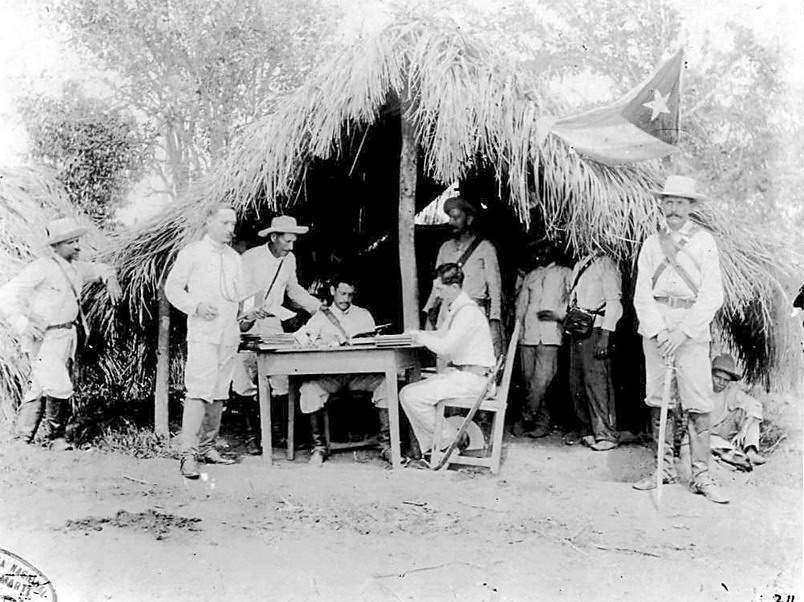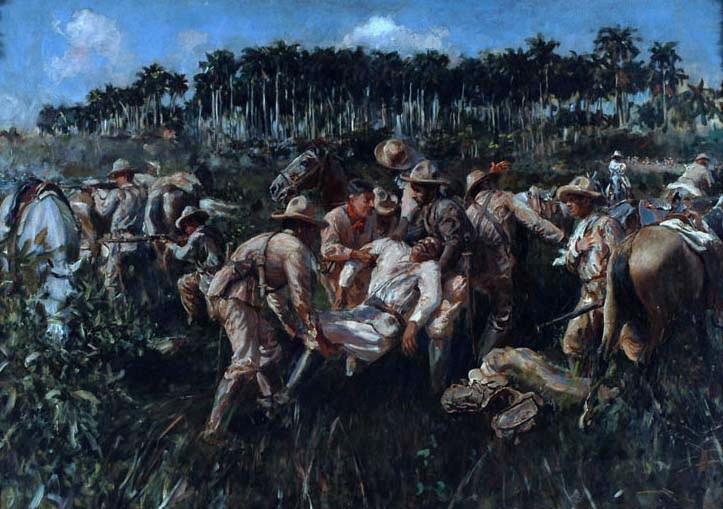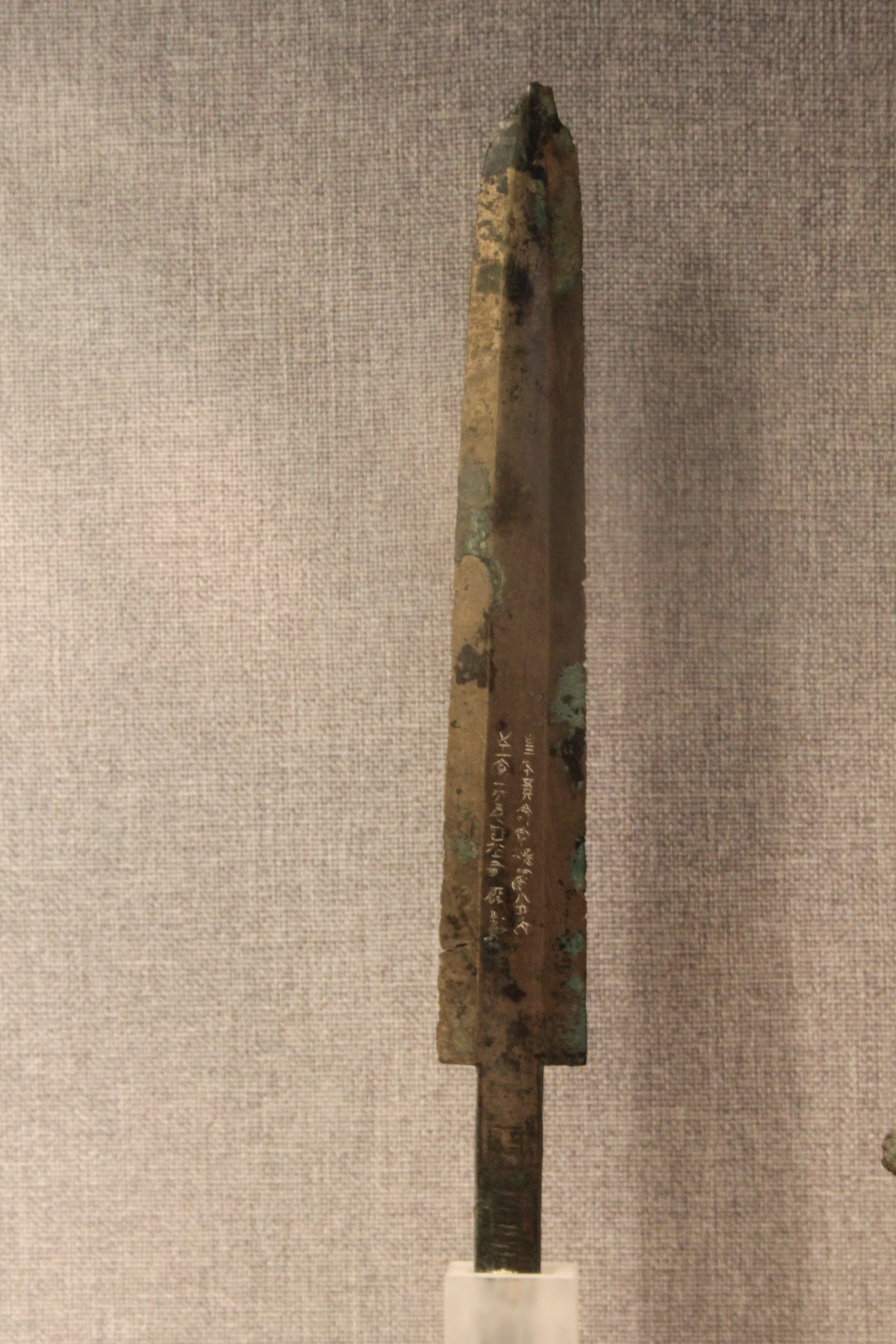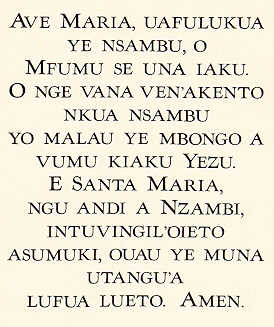|
Mambises
The mambises were the guerrilla independence soldiers who fought for the independence from Spain of the Dominican Republic in the Dominican Restoration War (1863–1865), and of Cuba in the Ten Years' War (1868–1878), Little War (1879–1880), and Cuban War of Independence (1895–1898). Origin The word ''mambí'' is of Afro-Antillean origin but the exact etymology is unknown. It is first recorded early in the annexation of the Dominican Republic to Spain (1861-1865), when it was some kind of deferential title given by friends and neighbors to Manuel de Frías, a septuagenarian Afro-Dominican farmer arrested by the Spanish for promoting disobedience against the colonizers. Frías, who was in his thirties when Haitian president Jean-Pierre Boyer conquered the Republic of Spanish Haiti in 1822 and abolished slavery, was convinced that the Spanish were going to reintroduce it, despite their reassurances to the contrary. After Frías escaped from prison, rumors of the reinstate ... [...More Info...] [...Related Items...] OR: [Wikipedia] [Google] [Baidu] |
Ten Years' War
The Ten Years' War (; 1868–1878), also known as the Great War () and the War of '68, was part of Cuba's fight for independence from Spain. The uprising was led by Cuban-born planters and other wealthy natives. On 10 October 1868, sugar mill owner Carlos Manuel de Céspedes and his followers proclaimed independence, beginning the conflict. This was the first of three liberation wars that Cuba fought against Spain, the other two being the Little War (Cuba), Little War (1879–1880) and the Cuban War of Independence (1895–1898). The final three months of the last conflict escalated with United States involvement, leading to the Spanish–American War. Background Slavery Cuban bourgeoisie demanded fundamental social and economic reforms from the Monarchy of Spain, Crown. Lax enforcement of the Slavery in colonial Spanish America, slave trade ban had resulted in a dramatic increase in imports of African diaspora, Africans, estimated at 90,000 slaves from 1856 to 1860. This occ ... [...More Info...] [...Related Items...] OR: [Wikipedia] [Google] [Baidu] |
Cuban Liberation Army
The Cuban Liberation Army (), colloquially known as the Mambises, Mambí Army () was an insurgency, insurgent army which was formed in the last third of the 19th century and fought for independence from Spain and the abolitionism, abolition of slavery. It first saw combat in the Ten Years' War (1868–1878) under the command of Carlos Manuel de Céspedes, Ignacio Agramonte, and Carlos Roloff. The independentists were decentralized and operated within their own regions autonomously of each other, until the Assembly of Guáimaro established the Republic of Cuba in Arms, Republic-in-Arms of Cuba and the Liberation Army's command structure. After the Pact of Zanjón, a brief uprising called the Little War (Cuba), Little War saw Majors-General Calixto García and Antonio Maceo Grajales, Antonio Maceo lead the Army of Liberation in another attempt at independence and the abolition of slavery, though unsuccessfully. Finally, during the Cuban War of Independence, War of Independence, the ... [...More Info...] [...Related Items...] OR: [Wikipedia] [Google] [Baidu] |
Cuban War Of Independence
The Cuban War of Independence (), also known in Cuba as the Necessary War (), fought from 1895 to 1898, was the last of three liberation wars that Cuba fought against Spain, the other two being the Ten Years' War (1868–1878) and the Little War (1879–1880). During the war, Spain sent 220,285 soldiers to Cuba—according to the Library of Congress, the largest army to cross the Atlantic until World War II. The final three months of the conflict escalated to become the Spanish–American War, with United States forces being deployed in Cuba, Puerto Rico, and the Philippines against Spain. Historians disagree as to the extent that United States officials were motivated to intervene for humanitarian reasons but agree that yellow journalism exaggerated atrocities attributed to Spanish forces against Cuban civilians. Background During the years 1879–1888 of the so-called "Rewarding Truce", lasting for 17 years from the end of the Ten Years' War in 1878, there were fundament ... [...More Info...] [...Related Items...] OR: [Wikipedia] [Google] [Baidu] |
Little War (Cuba)
The Little War or Small War () was the second of three conflicts between Cuban rebels and Spain. It started on 26 August 1879 and after some minor successes ended in rebel defeat in September 1880. It followed the Ten Years' War of 1868–78 and preceded the final war of 1895–98, which resulted in American intervention and Cuban independence. Origins The war had the same origins as the Ten Years' War, and in many ways, it was a continuation of it. Following his release after the Pact of Zanjón, Calixto Garcia travelled to New York City and organized the Cuban Revolutionary Committee with other revolutionaries. In 1878, he issued a manifesto against Spanish rule of Cuba. This met with approval amongst other revolutionary leaders, and war began on August 26, 1879. The war The revolution was led by Calixto García, having been one of the few revolutionary leaders who did not sign the Pact of Zanjón. Among the other prominent leaders were José Maceo (the brother of An ... [...More Info...] [...Related Items...] OR: [Wikipedia] [Google] [Baidu] |
Lance
The English term lance is derived, via Middle English '' launce'' and Old French '' lance'', from the Latin '' lancea'', a generic term meaning a wikt:lancea#Noun">lancea'', a generic term meaning a spear">wikt:lancea#Noun">lancea'', a generic term meaning a spear or javelin employed by both infantry">spear or javelin">spear">wikt:lancea#Noun">lancea'', a generic term meaning a spear or javelin employed by both infantry and cavalry, with English initially keeping these generic meanings. It developed later into a term for spear-like weapons specially designed and modified to be part of a "weapon system" for use couched under the arm during a charge, being equipped with special features such as grappers to engage with lance rests attached to breastplates, and vamplates, small circular plates designed to prevent the hand sliding up the shaft upon impact. These specific features were in use by the beginning of the late 14th century. Though best known as a military and sporting ... [...More Info...] [...Related Items...] OR: [Wikipedia] [Google] [Baidu] |
Rifle
A rifle is a long gun, long-barreled firearm designed for accurate shooting and higher stopping power, with a gun barrel, barrel that has a helical or spiralling pattern of grooves (rifling) cut into the bore wall. In keeping with their focus on accuracy, rifles are typically designed to be held with both hands and braced firmly against the shooter's shoulder via a buttstock for stability during shooting. Rifles are used in warfare, law enforcement, hunting and shooting sports, target shooting sports. The invention of rifling separated such firearms from the earlier smoothbore weapons (e.g., arquebuses, muskets, and other long guns), greatly elevating their accuracy and general effectiveness. The raised areas of a barrel's rifling are called ''lands''; they make contact with and exert torque on the projectile as it moves down the bore, imparting a spin. When the projectile leaves the barrel, this spin persists and lends gyroscopic stability to the projectile due to conservatio ... [...More Info...] [...Related Items...] OR: [Wikipedia] [Google] [Baidu] |
Pedro Santana
Pedro Santana y Familias, 1st Marquess of Las Carreras (June 29, 1801June 14, 1864) was a Dominican soldier and politician who served three times as the president of the First Dominican Republic (1844–1861) and was the first governor-general during the period of annexation of the Dominican Republic to Spain (1861–1865), accomplished at Santana's request. Called " Libertador de la Patria" in life, Santana is today considered a dictator because of his authoritarian rule. Santana was one of the signatories of the Manifesto of January 16, 1844 that proclaimed Dominican independence on February 27, 1844. He would assume the leadership of the southern expeditionary army and gain prominence for his victory in the Battle of Azua. He led a coup d'état against the Central Governing Board and was named president on a provisional basis. During his government, the first constitution of the Dominican Republic was promulgated, and he was designated the first constitutional president ... [...More Info...] [...Related Items...] OR: [Wikipedia] [Google] [Baidu] |
Spanish Cuba
The Captaincy General of Cuba () was an administrative district of the Spanish Empire created in 1607 as part of Habsburg Spain's attempt to better defend and administer its Caribbean possessions. The reform also established captaincies general in Puerto Rico, Guatemala and Yucatán. The restructuring of the Captaincy General in 1764 was the first example of the Bourbon Reforms in America. The changes included adding the provinces of Florida and Louisiana and granting more autonomy to these provinces. This later change was carried out by the Count of Floridablanca under Charles III to strengthen the Spanish position vis-a-vis the British in the Caribbean. A new governor-captain general based in Havana oversaw the administration of the new district. The local governors of the larger Captaincy General had previously been overseen in political and military matters by the president of the Audiencia of Santo Domingo. This ''audiencia'' retained oversight of judicial affairs until t ... [...More Info...] [...Related Items...] OR: [Wikipedia] [Google] [Baidu] |
Spanish Army
The Spanish Army () is the terrestrial army of the Spanish Armed Forces responsible for land-based military operations. It is one of the oldest Standing army, active armies – dating back to the late 15th century. The Spanish Army has existed continuously since the reign of Ferdinand II of Aragon, King Ferdinand and Isabella I of Castile, Queen Isabella (late 15th century). The oldest and largest of the three services, its mission was the defence of Peninsular Spain, the Balearic Islands, the Canary Islands, Melilla, Ceuta and the Spanish islands and rocks off the northern coast of Africa. History During the 16th century, Habsburg Spain saw steady growth in its military power. The Italian Wars (1494–1559) resulted in an ultimate Spanish victory and hegemony in northern Italy by expelling the French. During the war, the Spanish Army transformed its organization and tactics, evolving from a primarily Pike (weapon), pike and halberd wielding force into the first pike and shot ... [...More Info...] [...Related Items...] OR: [Wikipedia] [Google] [Baidu] |
Kongo Language
Kongo or Kikongo is one of the Bantu languages spoken by the Kongo people living in the Democratic Republic of the Congo (DRC), the Republic of the Congo, Gabon, and Angola. It is a tonal language. The vast majority of present-day speakers live in Africa. There are roughly seven million native speakers of Kongo in the above-named countries. An estimated five million more speakers use it as a second language. Historically, it was spoken by many of those Africans who for centuries were taken captive, transported across the Atlantic, and sold as slaves in the Americas. For this reason, creolized forms of the language are found in ritual speech of Afro-American religions, especially in Brazil, Cuba, Puerto Rico, Dominican Republic, Haiti, and Suriname. It is also one of the sources of the Gullah language, which formed in the Low Country and Sea Islands of the United States Southeast. The Palenquero creole in Colombia is also related to Kong creole. Geographic distribution Kongo wa ... [...More Info...] [...Related Items...] OR: [Wikipedia] [Google] [Baidu] |
Machete
A machete (; ) is a broad blade used either as an agricultural implement similar to an axe, or in combat like a long-bladed knife. The blade is typically long and usually under thick. In the Spanish language, the word is possibly a diminutive form of the word ''macho'', which was used to refer to sledgehammers. Alternatively, its origin may be ''makhaira, machaera'', the name given by the Greeks and Romans to the falcata. It is the origin of the English language equivalent term ''matchet'', though this is rarely used. In much of the English-speaking Caribbean, such as Jamaica, Barbados, Guyana, Grenada, and Trinidad and Tobago, the term ''cutlass'' is used for these agricultural tools. Uses Agriculture In various tropical and subtropical countries, the machete is frequently used to cut through rainforest undergrowth and for agricultural purposes (e.g. cutting sugar cane). Besides this, in Latin America a common use is for such household tasks as cutting large foodstu ... [...More Info...] [...Related Items...] OR: [Wikipedia] [Google] [Baidu] |








